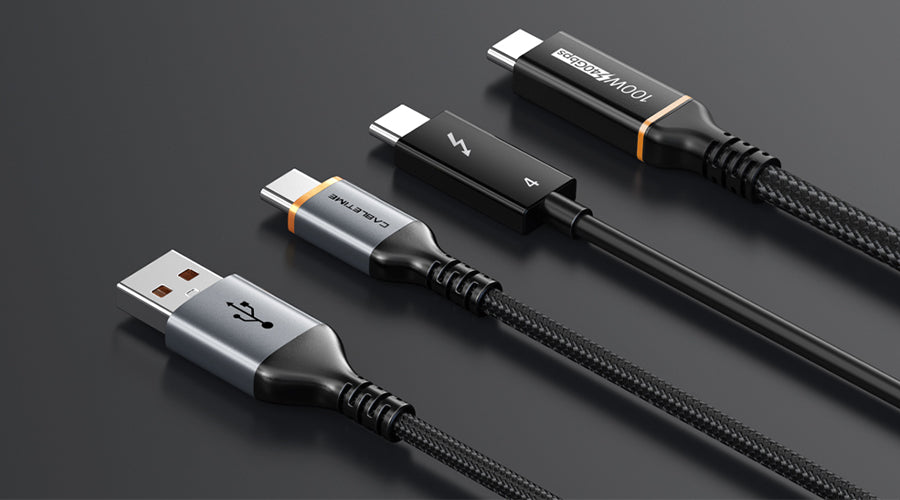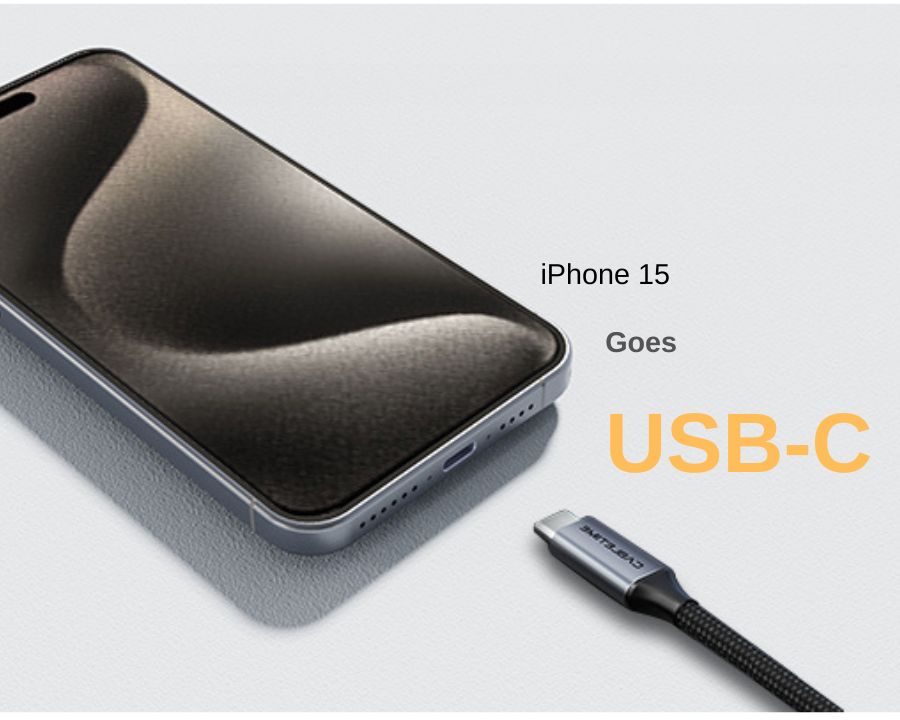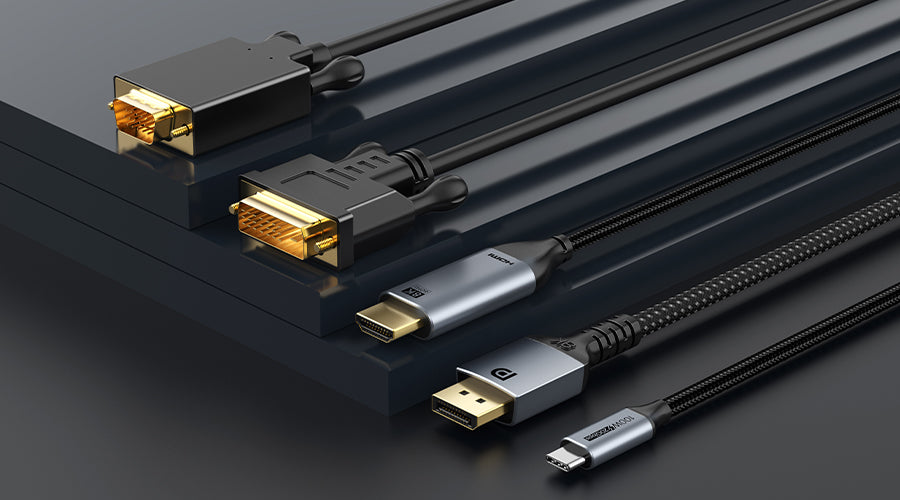The technology of data cable interfaces has evolved drastically, providing better connectivity and convenience. There were times when finding the correct orientation with a USB-A connector was a frustrating process. Now, Type-C USB reversible connectors offer a convenient connection with a minimalist design that every user craves. Since 2014, Type-C ports with USB 3, USB 4, Thunderbolt 3, and Thunderbolt 4 interface are the prime choices for any computer or electronic device that requires a power or data connection.

These interface and port types vary based on data, video, power, functionality, and support. This article will explore types of data cable interfaces. Clarify the difference between port, interface, and protocol. We aim to provide sufficient information for selecting the suitable interface for data transfer.
Development of Data Cable Interfaces
Data communication ports and interface technologies have rapidly changed since the advent of computers. The data cable interface started from serial, PS/2, and parallel ports to an advanced Type-C connector that works across all devices. Let's explore the background of USB interfaces and a little history to understand USB cable interfaces.
USB Founding Company
Intel introduced the first-ever USB (Universal Serial Bus) in 1995. Later, companies, including Compaq, Digital Equipment Corporation, IBM, Intel, Microsoft, NEC, and Nortel, worked together to make USB available for every computer. These companies were also the founding members of the USB Implementers Forum (USB-IF).
USB-IF is a non-profit organization that specifies and ensures the implementation of transmission procedures for electronic equipment worldwide. The primary purpose is to standardize the USB interface for a homogenous design approach by computer and electronics device manufacturers. The USB-IF also handles compliance programs and maintenance standards.
History of USB Port, Interface, and Protocol
Since the monodirectional USB-A port design, some interactive port design changes were made by USB-IF until the Type-C port arrived. We must know the difference between port, interface, and protocol to understand what data cable interface means:
What is a USB Port?
USB port is the physical shape of the connector that connects devices. There have been several changes to the physical form since the USB-A. Let's have a look at the details:
- USB-A: USB-A is the first ever connector shape introduced for the USB interface. It is a non-reversible rectangular-shaped connector found in computers, laptops, TVs, and other electronics. It is the most popular form of USB to date.
- USB-C: Amongst all the USB ports, the Type-C shape has lasted over a decade, mainly due to its minimalist design and comprehensive capabilities. We can see Type-C ports in smartphones, tablets, laptops, computers, IoT devices, and every device that requires a data or charging connection. The key highlight is its convenient oval-shaped connector with a reversible design.
- Micro-USB: It is a widely adopted port connector due to its non-reversible but non-symmetric design. Users can easily see the right insertion direction due to its rounded top and flat bottom.
- USB-B: The USB-B port is similar to USB-A in connectivity and characteristics. The only difference is the shape of the port. It is a square shape with beveled top corners. The beveled edges make the connector non-reversible.
- Mini-USB: The problem with non-reversible connectors is that it is hard for users to find the correct insertion direction. Mini-USB has a trapezoid shape.

What is a USB Interface?
A USB port may have a similar shape, but it can vary in the number of pins and communication speed. As users, it's essential to understand USB interfaces and their differentiating factors so that there is no bottleneck in communication speed between devices.
Currently, there are 10 USB interfaces that input/output designers utilize. Manufacturers use them in devices based on requirements. Some interfaces provide high-speed connection, but their data cables and ports have higher manufacturing costs. Devices that do not require high-speed data transfer for power transmission may use interfaces with lower data transfer rates but have low manufacturing costs. Here are the 10 USB interfaces with their characteristics:
|
Interface |
Date of Release |
Max Data Transfer Rate |
Number of Port PINs |
Features |
|
USB 1.0 |
May 1996 |
12 Mbps |
4 |
First USB specification supports both low-speed and full-speed devices |
|
USB 2.0 |
April 2000 |
480 Mbps |
4 |
Increased data transfer rate, supports plug-and-play devices |
|
USB 3.0 |
November 2008 |
5 Gbps |
9 |
New SuperSpeed mode with increased data transfer rate, new connector design |
|
USB 3.1 Gen 1 |
July 2013 |
5 Gbps |
9 |
Also known as USB 3.0 SuperSpeed |
|
USB 3.2 Gen 1 |
July 2017 |
5 Gbps |
9 |
Combines USB 3.1 Gen 1 and USB 3.0 into a single standard |
|
USB 3.2 Gen 2 |
July 2017 |
10 Gbps |
9 |
New SuperSpeed+ mode with increased data transfer rate |
|
USB 4 |
March 2019 |
40 Gbps |
24 |
Doubles the data transfer rate of USB 3.2 Gen 2, supports Thunderbolt 3 |
|
Thunderbolt 2 |
February 2011 |
20 Gbps |
20 |
Increased data transfer rate, supports dual 4K displays or a single 5K display |
|
Thunderbolt 3 |
June 2015 |
40 Gbps |
20 |
Doubles the data transfer rate of Thunderbolt 2, supports dual 4K displays at 60 Hz or a single 5K display at 60 Hz |
|
Thunderbolt 4 |
March 2020 |
40 Gbps |
20 |
Doubles the minimum PCIe bandwidth, supports Thunderbolt 3 docks and devices |
What is a USB Protocol?
The controller will activate specific protocols depending on the device type connected to the USB port. Each protocol may have its advantages and disadvantages. Here are some of the most popular protocols that USBs utilize:
- Bulk, Interrupt, Control, and Isochronous Transfer: Bulk transfer is activated once a USB data transfer device is connected. It is ideal for bulk data transfer but has a low response time. For keyboards and mice, interrupt transfer provides a rapid response time but has low data transfer capability. Designers use control protocol for device enumeration and configuration. Isochronous transfer is the most complex type of USB protocol, and it can transfer real-time data such as audio and video.
- Display Port: It is a video transmission protocol that can transmit audio. The primary purpose is to provide a monitor connection for display supporting high resolutions, refresh rates, and color depths.
- HDMI: It is a standard protocol for connecting consumer devices such as TVs, game consoles, and Blu-ray players. The use of audio along with video transmission is its most common use.
- MHL: The abbreviation is Mobile High-Definition Link. The protocol is available in smartphones and tablets for audio/video output to monitors and TVs. However, it requires a special cable for compatibility and operation.
The table below summarizes all the USB types, ports, interfaces, and protocols.
|
USB Port Type |
Port Shape |
Available Interfaces |
Supported Protocols |
|
USB-A and USB-B |
 |
USB 1.0, USB 2.0, USB 3.0, USB 3.1 Gen 1, USB 3.2 Gen 1, USB 3.2 Gen 2x2 (20 Gbps) |
Bulk transfer, Interrupt transfer, Control transfer, Isochronous transfer |
|
Mini-USB |
 |
USB 1.0, USB 2.0 |
No Major Change |
|
Micro-USB |
 |
USB 1.0, USB 2.0, USB 3.0 |
No Major Change |
|
USB-C |
 |
USB 2.0, USB 3.0, USB 3.1 Gen 1, USB 3.1 Gen 2, USB 3.2 Gen 1, USB 3.2 Gen 2, USB 4.0, Thunderbolt 3, Thunderbolt 4 |
Added support for DisplayPort, MHL, HDMI (only Thunderbolt 3 and Thunderbolt 4) |
Key Hardware Interface Features
There are currently 10 USB interfaces, and the number is increasing. Each interface is backward compatible if the data cable can connect to the USB port design. Users can utilize the maximum data, video, power, support, and other interface functionalities if they secure the correct port with a suitable cable. Here is the breakdown of the individual features of USB:
1. Data Transmission Speed
Data transfer speed depends on the interface. Some USB ports have limited data transfer speeds compared to others. Therefore, you will find a USB-A interface with a maximum data transfer speed of 10Gbps. In contrast, a Type-C port with a Thunderbolt interface can reach up to 40Gbps data transfer speeds. When buying an electronic device and data cable, always ensure they have the correct interface to allow the required transfer speeds.
As of now, there are optical Thunderbolt cables that support high-speed data transfer for its users. The resistance of the conductor inside the cable limits a data cable. Usually, they have thick diameters and short lengths. Optical thunderbolt cables are the best to transmit data over an extended distance. They can deliver data over an extended length of 150”.
2. Video Transmission
Video transmission capability of USB interfaces allows laptop, tablet, and smartphone manufacturers to utilize the small USB-C port design compared to DisplayPort or HDMI cables that require a larger connector.
3. Power Transmission
The power transmission capability of USB allows devices to receive power through a single cable and data connectivity. Different power transmission capabilities depend on the connector type and ability. Here are the two ports and their power transmission capability:
- USB-A: Four (4) pin interfaces, USB 1.0 and USB 2.0, can power devices with 5W power transmission capability. Nine (9) pin connector USB-A interfaces, namely USB 3.0, USB 3.1 Gen 1, USB 3.2 Gen 1, and USB 3.2 Gen 2, can deliver 4.5W power. Considering modern device charging and power requirements, the transmission capability of the USB-A port is low.
- Type-C: Ports with a Type-C design can feature up to 24 pins in a single connector. It allows superior data transmission and power delivery capability. A single Type-C USB port can deliver up to 100W power. Most modern smartphones, tablets, laptops, IoT, and other devices are shifting towards Type-C ports utilizing its versatility.
4. Equipment Supportability
USB interfaces and ports are everywhere, whether the electric shaver, toothbrush, or milk froth maker from your morning routine or the smartphone, laptop, tablet, or computer for any part of the day. Their versatility and standardized design allow electronics manufacturers to use them in almost any device.
Gamers using laptops as their gaming station can use the Thunderbolt 4 interface with USB-C interface to connect external graphic cards and devices requiring PCIe connection. Modern computers share PCIe lanes from the CPU or motherboard with the port for rapid data transfer speeds. Users can adjust the number of lanes the port utilizes through their BIOS settings. The USB-C port has opened new horizons for innovation by designers and manufacturers.
5. Function Scalability
USB connections have surpassed all other communication means. TVs, audio systems, storage devices, graphic cards, monitors, keyboards, mice, webcams, and other devices can all use USB to transmit power, video, audio, or data. Smartphones are rapidly adopting the USB-C port, and even the iPhone is switching to the USB-C port due to its widespread use and standardized design, which reduces waste.
Usage Scenarios
Rechargeable and powered electronics are now utilizing USB ports in their design. The technology that started from computers is now in grooming devices, home appliances, medical equipment, TVs, speakers, and more. The usage possibilities of an interface that supports power, video, audio, and data transmission are practically limitless. Here are some devices that use different interfaces for operation:
Uses of USB A
- Keyboard and mouse
- Printer or scanners
- Male to Male USB A cable for external hard drive
- USB flash drive
- Charging a smartphone using a USB charger
- Medical devices

Uses of USB-C
- Laptop to a monitor
- Smartphone to a TV
- External hard drive to a computer
- Charging a laptop using a USB-C charger
- Using an external graphics card with a laptop

Uses of USB 4
- Connecting a laptop to a high-resolution monitor
- Connecting an external storage device to a computer
- Using an external graphics card with a laptop
- Docking a laptop to a monitor, keyboard, mouse, and other devices

Uses of Thunderbolt 3 or 4
- Connecting a laptop to a high-resolution monitor
- Connecting an external storage device to a computer
- Using an external graphics card with a laptop
- Docking a laptop to a monitor, keyboard, mouse, and other devices
- Connecting multiple devices to a laptop using a daisy chain

Summary
Every USB port, interface, and protocol has unique and common uses. As users, we must be smart when buying a USB-based device or data cable. The device should support the latest technology and provide an adequate interface/port for maximum performance. After going through all the types, we can summarize the following ports and interfaces:
- USB-C: It is the longest-lasting port shape for USB. The application of the type due to its reversible design goes beyond just computers. IoT devices, tablets, smartphones, and home appliances can utilize its small port design and 100W power-delivering capacity. The capability to support the Thunderbolt 4 interface allows it to deliver data at 40Gbps.
- USB-A: The oldest and the first-ever port design was USB-A. Due to its simple design, the manufacturing cost is low. It is the most budget-friendly port design, with data transfer support up to 10Gbps and 4.5W power delivery.
- USB 4: It is the latest interface for USB data transfer. Utilizing the 24-pin Type-C connector, it can deliver 20Gbps and 100W power.
- Thunderbolt 3 and 4: Thunderbolt is everyone's favorite primarily due to its capability of transmitting video, audio, power, and data. It can deliver 100W power and support the latest display protocols like HDMI, DisplayPort, and MHL. Users can boost a screen resolution of 4K @ 120 Hz, dual screens setup with 4K @ 60 Hz, or a single screen 8K @ 60Hz.
So why wait? Check out the CABLETIME Intel Certified Thunderbolt 4 Cable USB C To USB C that supports an 8K 60HZ display. The cable has backward compatibility and a data transfer speed of up to 40Gbps. Start charging your device at 100W power using the high-end data cable.

Frequently Asked Questions
1. Is the USB C interface reversible?
Yes, the USB-C or Type-C port is a reversible connector released in 2014. Since then, it's been the top priority for any electronic device. There are many interfaces for the USB-C types. It can start by supporting a 20Gbps data transfer speed up to 40Gbps using a 20 or a 24-pin connector. The latest USB-C port Thunderbolt 4 protocol supports video, audio, data, and power transmission. It can boost 100W power through its port.
2. When using a USB C or Thunderbolt 3 connection, is it possible to transfer data and charge at the same time?
Yes, both these connections are USB PD (Power Delivery) capable. They can transfer data and simultaneously charge the device it's connecting. However, you will need a compatible cable with the correct number of connecting pins to ensure connectivity. The Thunderbolt 3 USB-C connection can deliver 100W of power and 40Gbps data transfer speed.
3. What is the maximum transfer rate of USB 4?
USB4 is the latest interface standardized by USB-IF. It is a fast, reliable, versatile connection interface with a maximum transfer rate of 40 Gbps. It is important to note that USB 4 is an interface and requires a 24-pin USB-C connector to deliver such high-speed data transfer. Be sure to pick a high-end cable like the CABLETIME USB4 Cable to reach the maximum speed.
4. How fast can USB C achieve in terms of data transfer?
The USB-C port is the most widely used port design for video, audio, data, and power transmission. The latest interface in USB C design is the Thunderbolt 4. With Thunderbolt 4, users can achieve a data transfer rate of 40Gbps. All you need is an accurate data cable that has a 24-pin connector.
5. Is the USB C charger compatible with all USB charging devices?
Yes, every USB-C charger can charge a device with a Type-C port. However, a laptop may require 100W charging power, whereas a Blood Pressure machine may require just 3.5W. There are charging standards like QC, AFC, SCP, etc. for different smartphones. Ensure the charger you purchase is a branded product instead of a knockoff.






1 comment
John
I would appreciate you can outline/compare cable pinout/wire-connection of USB-C 3.x and USB4
thank you
John
Leave a comment
This site is protected by hCaptcha and the hCaptcha Privacy Policy and Terms of Service apply.